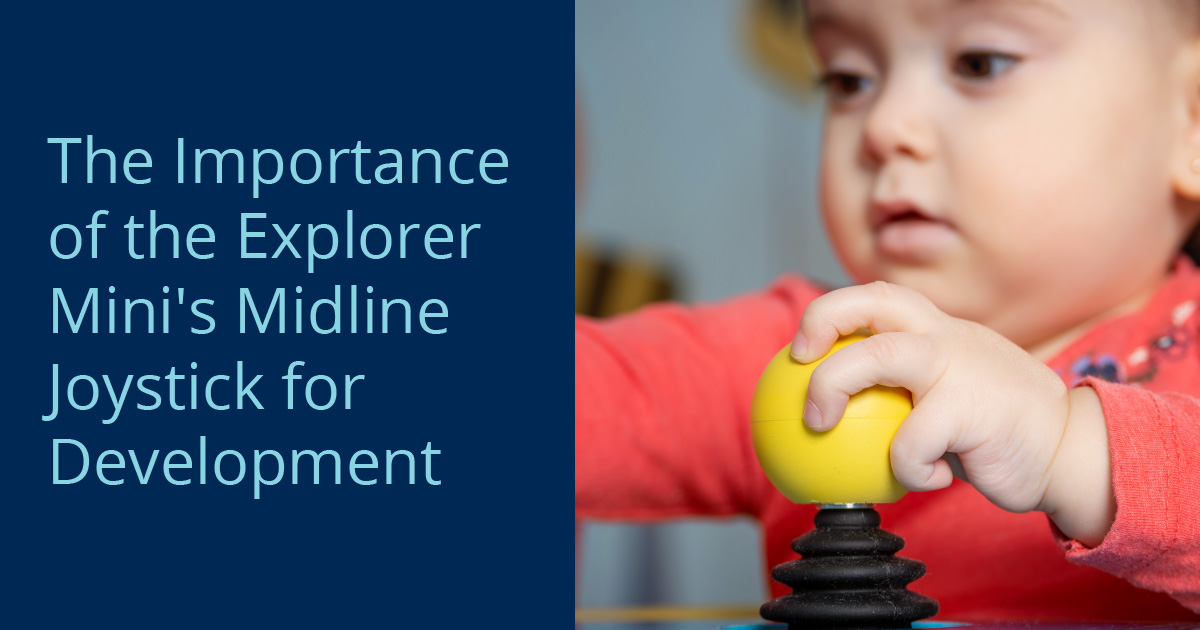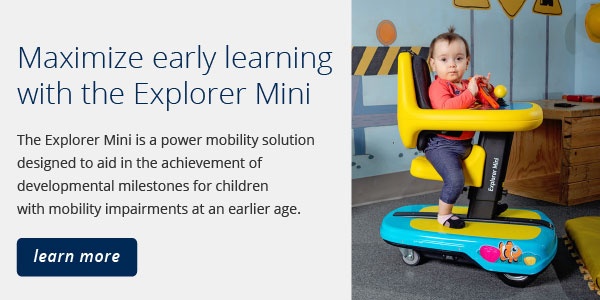Part 9 in our series about developmental milestones in early childhood focusing on mobility. See part 1, part 2, part 3, part 4, part 5, part 6, part 7, part 8, part 10, part 11, and part 12. Learn more about the Explorer Mini here.
Upper extremity function, such as reaching, grasping, and manipulating objects requires dynamic stability of the shoulder girdle on a stable trunk. The Explorer Mini tray provides this support to the upper extremities to allow for midline access to the joystick. The design of the midline joystick allows for the two hands to come together to support hand manipulation which contributes to handedness and haptic perception development.
What is Handedness Development?
Handedness or hand dominance typically occurs in children between the ages of 2-3 years of age. For children who are immobile and use a power mobility device with a joystick, hand dominance may be affected by the joystick placement to the right or to the left. Having a joystick in midline encourages bimanual exploration and allows hand dominance to be determined naturally. Additionally, having a joystick placement on the right or left may lead to scoliosis because the trunk may be hypotonic while the extremities may be hypertonic for example for children with cerebral palsy.

What is Haptic Perception?
Haptic perception is the recognition of objects and object properties by the hand without the use of vision. The hands and mouth are the primary sources of haptic information for an infant. “As the infant develops, the hands become a perceptual system that increasingly participates in the infant’s construction of knowledge” (2). Infants will first learn about their environment through haptic perception and as mobility develops their ability to interact with their environment allows for greater exploration.
“Vision appears to guide the development of haptic manipulation strategies. It is not until later in life that vision and somatosensory sensations appear to take on separate but supportive roles in object identification and use" (2). For this reason, it is a strategic part of development that the young child may “play” with the joystick, manipulating it, feeling the texture and even mouthing the joystick. Once he has an opportunity to develop the haptic perception and realize that what he is seeing is the same as what he is feeling, he may then come to realize that the joystick actually moves the device. Therefore, as part of training and exploration it is essential that the young child have adequate opportunities to explore the Explorer Mini before understanding that movement is part of the package.
How does posture affect upper extremity function?
Evidence supports that an upright posture versus a reclined posture improves upper extremity function such as reaching and manipulation (5). The posture that a child is put in with the design of the Explorer Mini is a forward posture, using weight bearing of the upper extremities.
1.Hagert, E., Persson, J., Werner, M., & Ljung, B-O. (2009). Evidence of wrist proprioceptive reflexes elicited after stimulation of the scapholunate interosseous ligament. American Society for Surgery of the Hand, 34A. 642-651.
2.Henderson, A., & Pehoski, C., (2006). Hand Functions in the Child: Foundations for Remediation, 2nd edition. Mosby, Elsevier. St. Louis, Missouri.
3.Michelson, JD, & Hutchins, C., (1995), Mechanoreceptors in human ankle ligaments. The Journal of Bone and Joint Surgery. British vol. 77-B
4.Rosenblum, S., & Josman, N. (2003). The relationship between postural control and fine manual dexterity. Physical and Occupational Therapy in Pediatrics, 23,(4). 47-60.
5.Stavness, C., (2006). The effect of positioning for children with Cerebral Palsy on upper-extremity function: A review of the evidence. PT and OT in Pediatrics, 26,39-52
6.Westcott, S., & Burtner, P. (2004). Postural control in children: Implications for pediatric practice. PT and OT in Pediatrics, 24, 5-55.
7.Scheiman, M. (2011). Understanding and managing vision deficits: A guide for occupational therapists. Thorofare, NJ: SLACK Incorporated.
 Dr Teresa Plummer, PhD, OTR/L, ATP, CEAS, CAPS
Dr Teresa Plummer, PhD, OTR/L, ATP, CEAS, CAPS
Associate Professor in the School of Occupational Therapy at Belmont University
Dr Teresa Plummer, PhD, OTR/L, ATP, CEAS, CAPS is an Associate Professor in the School of Occupational Therapy at Belmont University in Nashville, TN. She has over 40 yrs of OT experience and 20 in the area of Assistive Technology. She is a member of the International Society of Wheelchair Providers, and the Clinicians Task Force. She is a reviewer for American Journal of OT and guest reviewer for many other journals. She has presented internationally, nationally and regionally particularly in the area of pediatric power mobility. She has authored journal articles and textbook chapters in the area of OT and pediatric mobility and access.

